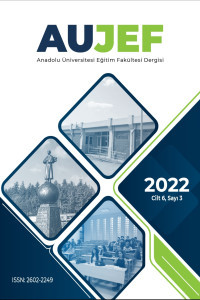Gençlere Yönelik Almanca Ders Kitaplarında Metin Türleri ve İncelenmesi
Genç bireylerin biyolojik, zihinsel ve sosyal gelişimleri, çocuk ve yetişkin hedef kitlelere göre farklılaşmaktadır. Dolayısıyla genç bireylerin öğrenme biçimlerine göre dikkatelerini çekecek materyal kullanımının önemi ortaya çıkmaktadır. Bu bağlamda gençler için üretilmiş günümüz Almanca ders kitaplarında gençlerin ilgi alanlarına yönelik konular ve metin içeriklerinin bulundurulması kaçınılmazdır. Gençlere yönelik yabancı dil öğreniminde kullanılan Almanca ders kitaplarında gençlerin ilgilerini çekebilecek ve onları motive edecek en önemli araçlardan biri, bu kitaplarda yer alan metinlerdir. Bu çalışmanın amacı uluslararası alanlarda kullanılan başlangıç seviyesindeki iki güncel Almanca ders kitabı örneğinde, kullanılan metin türlerini ve içeriklerini incelemektir. Bu amaç doğrultusunda Almanca ders kitapları örneğinde kullanılan metinlerin, gençlerin ilgi alanları ve gereksinimlerini ne derecede etkileyebileceği konusu incelenmiştir. Çalışma bulgularını elde edebilmek için her iki kitapta metin türleri ve incelemesi için nitel araştırma yöntemlerinden doküman analizi tekniği uygulanmıştır. Çalışmanın sonucunda her iki Almanca ders kitabında metin türleri açısından kullanmalık metinlerin yoğun bir biçimde kullanıldğı tespit edilmiştir. Belirtilen Almanca ders kitaplarında kullanmalık metinlerin kullanım amaçları olarak, hedef dildeki günlük hayatı yakından tanımak, gençlerin dikkatlerini farklı içerikler ile çekmek, güncel dilin kullanım zenginliğini yansıtmak, hedef ktitleyi eylem odaklı yönelimlere teşvik etmek ve kültürel bilgiler edinmek amacıyla yer aldığı belirlenmiştir.
Anahtar Kelimeler:
Almanca yabancı dil öğretim kitapları, genç hedef kitlesi
Text Types and Analysis in German Coursebooks for Young People
The biological, mental and social developments of young individuals differ from those of children and adult target audiences. Therefore, the importance of using materials which will attract young individuals’ attention according to their learning styles is evident. In this context, it is inevitable for current German coursebooks which are published for young people to include topics and texts according to their interests. One of the most attention grabbing and motivating tools in German coursebooks used in foreign language teaching for young people is the texts present in these books. The purpose of this study is to analyse the types of texts and their contents in two up-to-date beginner level German coursebooks used in international areas. For this purpose, it is examined in this study to what degree the texts used in the German coursebooks affect young people’s interests and needs. To obtain the findings of the study, the document analysis technique, which is one of the qualitative research methods, was used for the text types and their analysis for both books. As a result of the study, it was found that pragmatic texts were intensively used in both German coursebooks. It is determined that getting to know the daily life in the target language, attracting young people’s attention with different contents, reflecting the richness of the contemporary language, encouraging the target audience towards action-oriented tendencies and obtaining cultural knowledge are among the purposes of using pragmatic texts in the mentioned German coursebooks.
___
- Bärlund, P. (2006). Zur Authentizität im Fachbezogenen Fremdsprachenunterricht. Didaktisiertes Lehrmaterial mit Beispielen aus dem Bekleidungsdesign. (Unveröffentlichte Magisterarbeit). Universität Jyväskylä: Deutsche Sprache und KulturBölükbaş, F. (2015). Yabancı Dil Olarak Türkçe Öğretiminde Okuma Metinlerinin Dil Düzeylerine Göre Sadeleştirilmesi. International Journal of Languages’ Education and Teaching, Special Issue Udes2015, 924-935Cools, D. & Sercu, L. (2006). Die Beurteilung von Lehrwerken an Hand des Gemeinsamen Europäischen Referenzrahmens für Sprachen: Eine empirische Untersuchung von zwei kürzlich erschienenen Lehrwerken für Deutsch als Fremdsprache. Zeitschrift für Interkulturellen Fremdsprachenunterricht, [Online]: http://www.ualberta.ca/~german/ejournal/Cools_Sercu1.htmGülcan, Ç. (2006). Zur Frage der Authentizität in Lehrwerken des Deutschen als Fremdsprache. PHILOLOGIA - Sprach¬wissen¬schaftliche Forschungs¬ergebnisse, Band 90. Durmuş, M. (2013a). İkinci/yabancı dil öğretiminde sadeleştirilmiş metin sorunları üzerine. Bilig, 65, 135-150. Durmuş, M. (2013b). İkinci/Yabancı Dil Öğretiminde Özgün ve Değiştirilmiş Dilsel Girdi Üzerine. Turkish Studies, 8(1), 1291-1306. Günay, V. D. (2007). Metin Bilgisi. İstanbul: Multilingual Yayınları.Funk, H. (2004). Qualitätsmerkmale von Lehrwerken prüfen – ein Verfahrensvorschlag. Babylonia, 3, 41-47. Matzer, E. (2003). Der Gemeinsame Europäische Referenzrahmen für Sprachen (ERS) als Orientierungsgrundlage zur Lehr- und Lernzielbestimmung. ÖDaF–Mitteilungen, 1,7-19.Genç, A. & Ünver, Ş. (2012). Türkiye’de Geçmişten Günümüze Almanca Öğretimi İçin Yazılan Ders Kitaplarındaki Metinlerin İncelenmesi, Eğitim ve Bilim, 37 (163), 67-79.Güler, G. (2005). Avrupa Konseyi Ortak Dil Kriterleri Çerçeve Programı ve Türkiye’de Yabancı Dil Öğretim Süreçleri. Trakya Üniversitesi Sosyal Bilimler Dergisi, 6 (1), 89–106.Gilmore, A. (2007). Authentic Materials and Authenticity in Foreing Language Learning, Language Teaching, 40(2), 97-118.Krumm, H. J. (1994). Stockholmer Kriterienkatalog. In: B. Kast & G. Neuner (Hrsg.): Zur Analyse, Begutachtung und Entwicklung von Lehrwerken für den fremdsprachlichen Deutschunterricht (S.100-105), Berlin: Langenscheidt..Salomo, D. (2014). Deutschland, Deutschlernen und Deutschunterricht aus der Sicht von Jugendlichen und Lehrkräften in verschiedenen Ländern weltweit. Goethe-Institut e.V., Bereich Sprache.Quetz, J. (2003): A1-A2-B1-B2-C1-C2 Der Gemeinsame europäische Referenzrahmen. Deutsch als Fremdsprache, (1), 42-48.Yıldırım, A.& Şimşek, H. (2008). Sosyal Bilimlerde Nitel Araştırma Yöntemleri. Ankara: Seçkin Yayınevi.
- ISSN: 2602-2249
- Yayın Aralığı: Yılda 4 Sayı
- Başlangıç: 2017
- Yayıncı: Anadolu Üniversitesi
